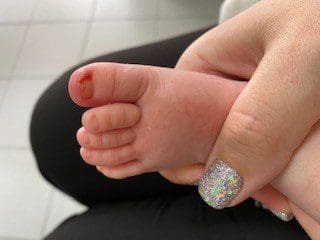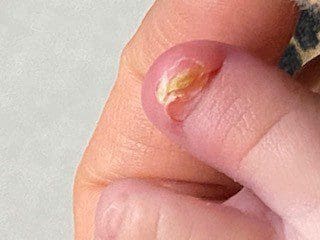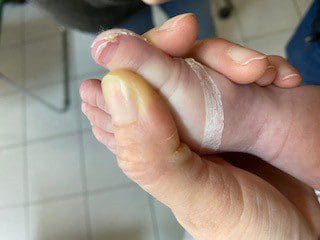
Ingrown nail in infants and young children
So, we already have a chapter on this website that covers the basics about nails in infants (read here). That chapter discusses routine issues and habits while this one will focus on the common medical condition – ingrown nails in infants. When discussing this topic for this particular population, there is slightly different emphasis that needs to be placed as opposed to when discussing ingrown nails in older children.
The following chapter was written by Caroline Semah, a podiatrist (a feet expert and surgeon), who also runs a successful website (link here).
What is an ingrown nail?
This happens when the edge (or the lateral aspect), of the nail does not allow for continued growth in the same path, towards the external end. Instead, the sharp edge of the nail penetrates the skin and injures it. We see ingrown nails mostly in the first toes, and more so in boys than in girls (at a ratio of 2:1).
What causes ingrown nails in infants?
We all know that in older children the cause can vary – trauma, tight-fitting shoes, excessive sweating, and more. There are babies, however, that present with ingrown nails already at one week of age, and this brings us to the understanding that the cause in infants is most probably a local pressure on the nail that develops intrauterine.
Let me remind you that already in the 20th week of gestation, the fetus has a full-grown nail, and so any direct pressure to their nail could cause an ingrown nail and inflammation.
What are the different stages that an ingrown nail undergoes?
First stage – mild pain, redness and swelling at the edge of the nail. See the first image.
Second stage – pain continues, redness, swelling and pus forms together with small lesions. See the second image.
Third stage – chronic inflammation with formation of excess skin, swelling and bleeding.

How do you treat ingrown nails in infants?
The approach in infants is mostly conservative treatment and minimizing surgical intervention.
Pharmacological therapy – the use of antibiotic ointments or honey-based ointments (yes honey!) that aid with healing.
Bandage therapy – divergence of the swollen skin that wraps the nail with the use of a bandage, kept on for several weeks. The ingrown nail is then able to grow externally, and this brings the inflammation and pain to an end. See the image below for a representation of how the bandage “pulls” the skin away from the nail.
Cutting the nail – in cases where there is an inflammation with pus production and swelling, the penetrating edge can be cut, of-course by a professional and not by the parents.
Titanium devices – straightening the nail with the help of a titanium device (similar to teeth straightening by an orthodontist), a method named ‘orthogrip’. This can bring about significant relief, it is pain-free and does not have any long-term limitations. The technique is feasible because nails have a keratin component that allows for flexibility and straightening without any pain. The problem with this technique is that it takes time, sometimes it could take up to months. On the other hand, the results are great and can be maintained for an extended period of time.
Surgical treatment – in cases when there is no improvement after having tried one of the above methods, the painful area can be treated surgically under general anesthesia. During the surgical procedure, the root of the nail edge that is penetrating the tissue is neutralized so that this edge can no longer grow to cause an ingrown nail.

What should never be done? The removal of the entire nail is not recommended. The new nail may not grow well, and the procedure could damage the growing base of the nail. Also, if the nail itself has an abnormal shape, the problem will recur, and an additional intervention will need to be carried out, regardless.
To summarize, the inability to communicate with the infant emphasizes the need for consistent parental observation and examination of their nails to ensure that all is well.
Make sure to cut your infant’s nails straight and remember not to cut towards the edges or deeply.
When your child grows, make sure their socks and shoes fit well.
If any problems arise, see the doctor or podiatrist nearest to you….
For comments and questions, please register
